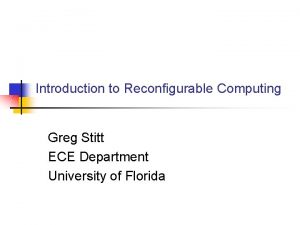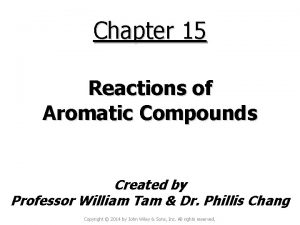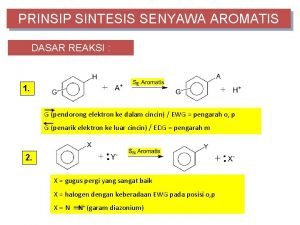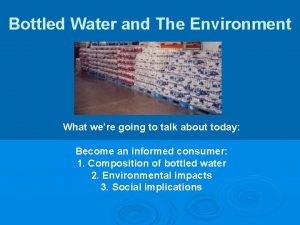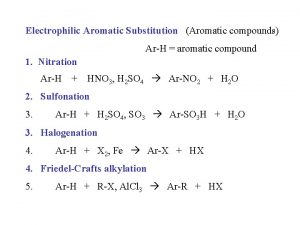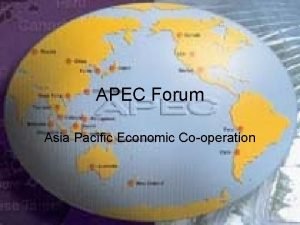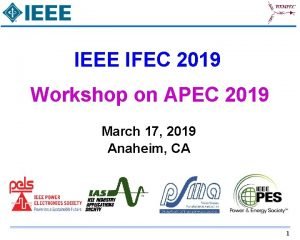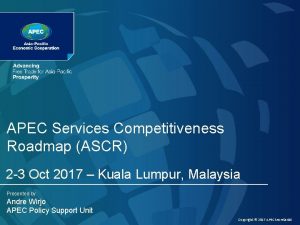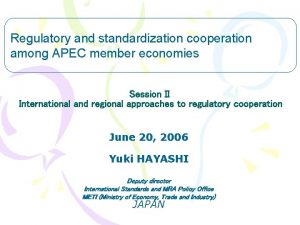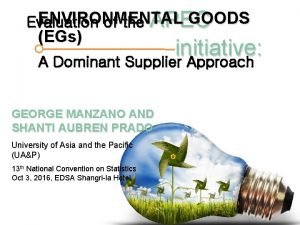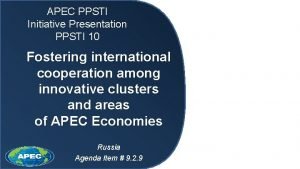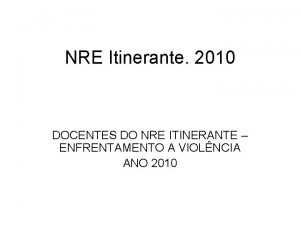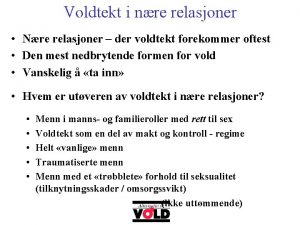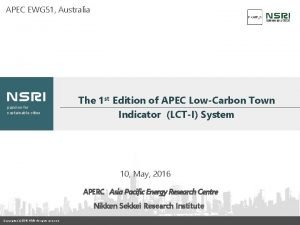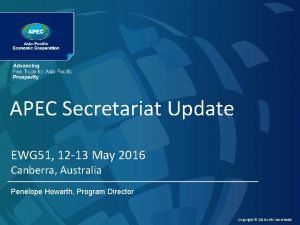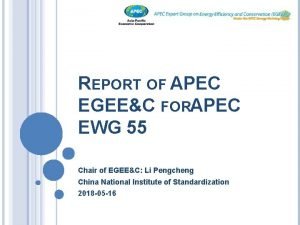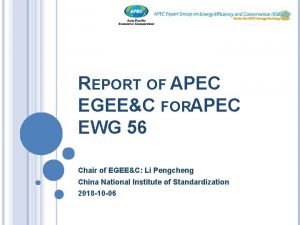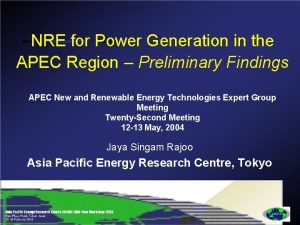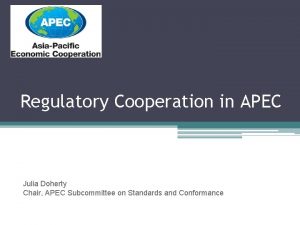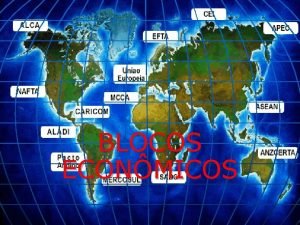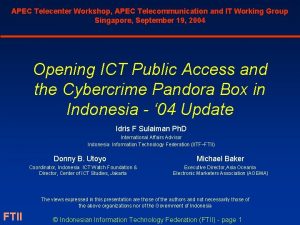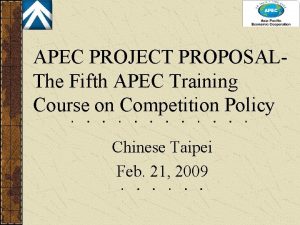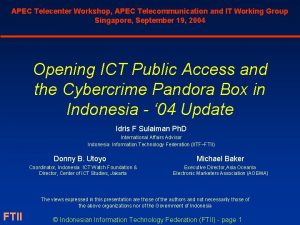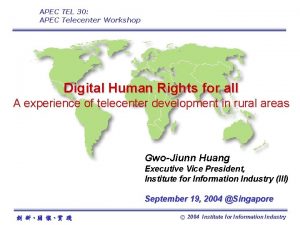APEC EWG NRE EXPERT GROUP 20 TH MEETING




















- Slides: 20

APEC EWG N&RE EXPERT GROUP 20 TH MEETING Village Power Opportunities and Challenges in Chinese Taipei Huang WU Energy Commission Ministry of Economic Affairs Chinese Taipei November 4, 2002, Seoul 1

Background Chinese Taipei is densely populated and over 99% enjoy electricity services. Opportunities on renewable village powers are relatively limited : Remote Areas or grid capacity insufficient Endowed with rich renewable energy sources VPS can play role to assist government achieve policy goals for a stable, efficient, clean electric supply system 2

Energy Supply Structure in Chinese Taipei * Annual increased by 6. 1% during last two decades * Limited indigenous supply, 97% importation 108. 5 MKLOE 2. 1% 8. 2% 7. 1% 58. 5 MKLOE 32. . 9 8. 0 % 3. 6% 5. 1% 2. 5% 15. 0 % 5. 5% 50. 3 % MKLOE 67. 7% 15. 6% 85. 3% 96. 9% GDP (US$) : 2, 542 billion Dependency of Importation: 53. 8 % 23. 2 % 95. 3% 5, 519 billion 32. 3 % 9, 376 billion 3

Energy Consumption by Energy Type *Electricity shares increase, oil products decreased. 9, 483 MKLOE 1991~2001 annual Growth Rate Energy Consumption : 5. 6% GDP: 5. 4% 47. 6% 5, 519 MKLOE 1981~1991 annual Growth Rate Energy Consumption : 6. 8% GDP: 8. 1%。 2, 852 MKLOE 34. 2% 5. 4% 41. 9% 38. 8% 41. 8% 51. 4% 9. 0% 2. 5% 12. 4% 11. 1% 4

Electricity Generation Capacity (by business types) Annual Growth Rates (1981 -2001): ŸTotal Installed Capacity : 6. 5% ŸPeak Load Demand : 7. 0% 35, 570 MW 15. 3% 7. 6% 19, 770 MW 7. 0% 77. 1% 10, 160 MW 100. 0 % Reserved Rates: 15. 3% 93. 0% 4. 8 % 13. 2 % 5

Electric Installed Generation Capacity (by fuel types) 35, 57 0 MW 6. 8% 7. 3% 14. 5% 19, 770 MW 10, 160 MW 13. 7% 22. 2% 54. 5% 9. 6% 8. 2% 5. 1% 26. 0% 3. 8% 18. 2% 20. 1% 32. 3% 24. 6% 33. 1% 6

Framework of Energy Policy Background Changes in Foreign & Domestic Energy Situation Trend toward Liberalization of the Energy Industry Increased Environmental Protection Pressure Energy Policy in Chinese Taipei Policy Guidelines Overall Objective Stabilizing Energy Supply Promoting Energy Efficiency Deregulating Energy Enterprises Enhancing Energy Safety and Environmental Protection Reinforcing Energy Research and Development Promoting Energy Education and Dissemination Liberalized, Orderly, Efficient, and Clean Energy Supply and Demand System 7

Village Power Opportunities in Chinese Taipei The opportunities on renewable village powers are limited, some areas may remain potentials: Small islands andremote areas that are sparsely populated. Penhu (39, 846 household), Jimen (19, 792 household), Machu (3, 999 households). There about 100 diesel-power generators under operation on these islands, with a total installed capacity of about 200 MW, providing a peak power supply of over 110 MW. Due to the high unit cost of diesel power generation, plus noise and environment concerns, these isolated systems are good candidates under this category. Areas that endowed with renewable energy resources: western coasted areas with wind energy; Agriculture or Feedstock wastes Areas that power grid capacity insufficient: The construction of power grid 8

Village Renewable Potentials in Chinese Taipei -stable , efficient, clean supply of electricity Windy west coast areas (Wind Farm) Off shore islands Agricultural & Feedstock wastes Interconnection Sea Cables feasibility study Off shore small islands 9

Village Power Application in Chinese Taipei Renewables : wind, solar PV Hybrid System Cogeneration : co-generation of steam; chilled water and othermal utilization. Other Coversion Technolgies : Fuel Cell; Micro-turbines 10

Key Tasks for Promoting Village Power in Chinese Taipei Removing non-economical barriers Liberalization of the electricity markets Land acquisition and permission use Providing Incentives for application of renewable energy providing financial incentives (tax credit, subsidize) legislating “Renewable Energy Development Bill” Promotion of RD&D Solar Cities (BIPV) : integrate with architect building designer Wind Farms: Green Islands: a feasibility study to convert the Green Island Pon. Hu Islands into a sustainable energy demonstration island. The result of these studies will be available next year. Technological reserch and devepment: cost down, high efficiency and tablility; (ex. nanotechnolgy application) 11

Challenges for the Power Generation Deregulation Strategies in Response: 1. Opening of the Independent Power Generation Industry 2. Revision to the“Electricity Law” proposed a deregulated Utilities 3. Deregulation of State-Own Utilities 12

à Status of IPP Promotion ◎Chang. Sen 900 MW(NG) ※Ku. Kung 480 MW(NG) 桃園縣 台北縣 ◎Shin. Tao 600 MW(NG) 新竹縣 宜蘭縣 苗栗縣 ※Sin. Lung 490 MW(NG) ◎Mai. Liang 1800 MW(Coal ) 台中縣 彰化縣 南投縣 雲林縣 花蓮 縣 嘉義縣 ※Chia. Huai 670 MW (NG) 1 st phase IPPs 2 nd phase IPPs 註: 台南縣 高雄縣 ※Sun. Ba 980 MW(NG) ◎Hopeing 1300 MW(Coal) 台東縣 3 rd phase Ipps 屏東縣 ◎Commercial Operation ※Under construction Since 1999, IPP has entered into power market. There will be totally 8 plants with a capacity of 7, 200 MW. 13

Liberalization of Power Industry in Chinese Taipei Integrated Utility Existing Generation IPPs (Non-utility) Generation ISO (Non-utility) Whole Sale Contract Electric Firms Obligation for renewable: 1. self construct 2. contracted with others 3. fund Transmission Distribution Obligation for supply General Users Selfproducer Contract Users Self-built tie-lines Obligation of hydro, nuclear and renewable power supply. Setting a renewable quota for purchasing or self-construction New Generation Direct users No renewable obligation for small plants Selfuses 14

Promotion of Renewable Energy Main Impediments: 1. Formulating strategies for the development of Renewable Energy in response to the impact of the United National Framework Convention on Climate Change 2. The cost of renewable energy is still too expensive to be widely applicable for domestic power generations. 3. Many more non-technical barriers than anticipated for the promotion of RE. 15

Promotion of Renewable Energy Strategies in Response: 1. A” Renewable Energy Promotion Program” in the form of an executive order to coordinate all parties involved toward the rapid removal of all nontechnical barriers to the promotion of RE. 2. To create a sustainable environment favoring utilization of renewable energy, a ” Renewable Energy Development Bill” has been submitted to the Congress for approval in August 2002. 16

Current Incentives for Promotion Renewable Energy 17

Legislating Renewable Development Bill Key Elements 18

Strategies for Promotion of Renewable Energy Long-term trend of generation cost 2. 0 Scale-UP and Technological advancement PV 15 -24* External Costs 1. 5 NT$/Kwh 補貼 1. 0 A > 1. 7 Renewables 0. 5 B 1. 27 Renewables Long-term trend Traditiona l Energies Traditional Energies 0 Z 2. 0 Y N T $ /K w h 1. 5 1. 0 0. 5 0 X Current Incentives Renewables X Z Demonstration Y Electricity subside High cost or new technology X Install subside Traditiona l Energies *battery included Stipulated by the law 19

Concluding Remarks 1. The Promotion of Village Renewable Power would require breakthrough in various regulations (e. g. land-use, building codes, gridconnection standards etc), which require interagency coordination mechanism to overcome multiple barriers. 2. To initiate DG and speed up the utilization of Village RE, the revision to the “Electricity Law”, the formulation and passage of “Renewable Energy Act” and the execution of “Renewable energy promotion program” are among the most important actions to be undertaken by the government. 3. A clear and definite target for RE development has been committed, with good progress to date. 20
